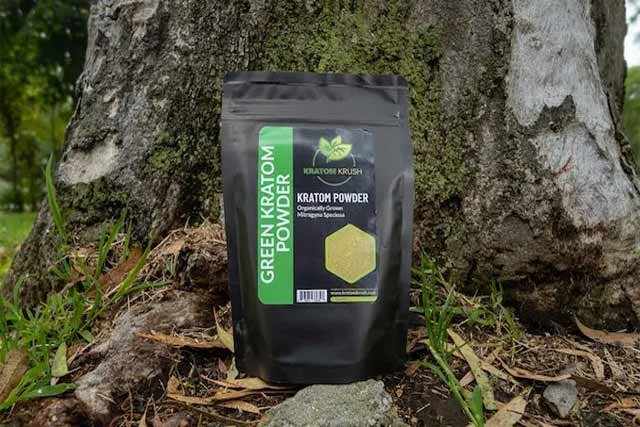The internet is full of conflicting information about what it’s like to take kratom. As someone who has been taking and benefitting from various strains for many years, I’ll be happy to bring some clarity to the topic.
Kratom (Mitragyna speciosa) is a plant native to Southeast Asia with intriguing therapeutic properties. Products containing kratom induce various effects depending on the strain, including stimulation, relaxation, and euphoria. Dosage also impacts what kind of experience the user will have.
In this guide, I’ll introduce you to several strains and describe what to expects. I’ll also share a few tricks to help you get more from your kratom products! Let’s begin!
How Does Kratom Feel?

Kratom is best-known for making you feel relaxed and, in big doses, euphoric. With its opiate-like, soothing properties, kratom is great at easing pain and discomfort.
It also serves as an effective muscle relaxant, which is more than ideal for improving sleep quality.
The euphoria produced by kratom makes it a popular recreational substance. The kratom “high” will put you in a good mood and also make you more sociable.
This ties in with its anti-anxiety effects. Kratom helps you forget about your troubles, live in the moment, and find pleasure from social situations again.
In contrast, some types of kratom – notably white leaf strains – have stimulating effects comparable to caffeine. Did you know the kratom plant is part of the coffee family?
The energy boost from these strains boosts your focus and attention span, provides mental clarity, and gets your creative juices flowing.
Side Effects of Kratom

Not all kratom experiences are positive, but limiting side effects is easy if you’re sensible.
A nasty headache is the most common kratom side effect. This typically happens when you take too much, but new users can also get side effects with moderate dosages because their tolerance is much lower.
If you haven’t taken kratom before, a small amount (around 2 to 3 grams) is plenty. I love kratom, and I want other people to love it, too.
But I’ve heard too many stories of first-timers overestimating what they can handle and then suffering from grim side effects.
Trust me, you will have loads of time to experiment with higher quantities after getting initiated with some low dosages.
Read More: How to Make Kratom Tea Like Professional Herbalists
Do Different Strains Provide Different Effects?
Yes! While white, red, and green kratom properties are broadly similar, the strain also influences the effect.
Maeng Da kratom is famous for being very potent; Bali is thought of as the most “opioid-like” strain, while Malaysian strains are popular for balancing sedation and stimulation. But color is the most important factor in determining a kratom product’s effects.
Red Kratom Strains

These are the strains you need for pain relief, sleeping problems, anxiety, stress, and mood issues.
Red kratom strains like Red Bali and Borneo are deeply sedative, and are ideal for unwinding and relaxing with.
Kratom is often referred to as a natural and less addictive alternative to opioid painkillers, and red strains fit that description better than any other.
Because red kratom makes you sleepy – and in large doses – high, I prefer to use them at the end of the day.
This allows me to fully destress and embrace kratom’s effects, without having to worry about carrying out any important tasks. That said, certain red strains still stimulate in low doses – Red Maeng Da is a good example.
Red Bali is my favorite red kratom. I need a powerful strain for the sort of pain relief I need, and Red Bali is up to it. What’s more, I get the bonus of being in a happy and playful mood while I’m on it.
Red Bali is excellent if you’re looking to take the relaxation and euphoria to the next level.
White Kratom Strains

White strains are more about stimulation than sedation.
The energizing effects from the likes of White Thai and White Sumatra have proven popular with laborers in Southeast Asia for centuries.
The physical and mental boost from white kratom is released over many hours, helping you stay attentive throughout the day.
Maybe you struggle to stay fully focused on work and your productivity is slacking. Or perhaps your mental clarity is slightly off, making studying that much harder. White kratom can solve your problems, without creating new ones.
What do I mean? Well, many people drink coffee for this purpose but find it leaves them jittery and anxious. Use kratom safely and you’ll have neither of these issues. Just one word of advice.
Take white kratom in the mornings or early afternoons – you don’t want to be buzzing with energy at bedtime!
Some white kratoms are more energizing than others. White Thai is especially stimulating, but White Bali has some relaxing effects in moderate to high doses.
Don’t be afraid to experiment with different strains – it can take time to find the ideal set-up!
Green Kratom Strains

Kratom’s invigorating and calming effects meet somewhere in the middle with green strains.
These strains are about balance and giving you a bit of everything – energy, pain relief and euphoria.
Say you want pain relief and a mood boost, but need to stay focused and don’t want to get too high. Green Malay and similar strains rise to the occasion, with lovely mellowing effects. There’s even some subtle variation among green kratoms, with Green Bali tilting slightly toward extra relaxation and Green Thai more energy.
But ultimately, green kratom is popular for its all-around qualities. It’s a great morning motivator, and equally good as an evening de-stressor. I recommend green strains often as they are a brilliant introduction to kratom, side-lining the more intense effects for something smoother.
What is Gold Kratom?
You may have seen gold kratom for sale at popular US vendors like Kratom Krush. Gold kratom is surrounded by mystery, and there are several theories as to how it’s made.
Some argue that gold kratom undergoes a special curing process after cultivation. Others suggest gold kratom products combine multiple strains. Gold kratom is usually very potent, although strains can be a little unpredictable. This could be explained by Southeast Asian growers using different cultivation processes for gold kratom.
A lot of people swear by gold kratom, and I’ve had some of my best sessions with it. For connoisseurs, it’s a must-try. But kratom newbies are better off trying a green, white, or red strain before going for gold.
What Provides These Feelings?

Time to get geeky with some science! Kratom is a complex plant consisting of several compound types, but it is the 40 or so alkaloids that make all the difference. We can narrow our hunt for kratom’s effects down to two alkaloids in particular: mitragynine and 7-hydroxymitragynine.
These alkaloids interact with the body similarly to prescription opioids, such as codeine, by binding with mu-opioid receptors. Crucially, kratom alkaloids do not bind as strongly with these receptors as regular opioids, which is why you are less likely to get addicted to kratom.
Mitragynine is the most important and abundant active alkaloid in kratom. Most studies on mitragynine were carried out on animals. Research on animals is somewhat helpful, but no substitute for human trials.
Other research shows that kratom strains have different levels of mitragynine, which would explain the variation in effects. Since kratom has different effects in low and high dosages, mitragynine is probably a biphasic compound.
Furthermore, a 2019 review paper in the Current Drug Targets journal concluded that kratom is a potential treatment for chronic pain. I could have told them that years ago!
We know less about 7-hydroxymitragynine, a terpenoid indole alkaloid. Fancy name! But believe it or not, researchers did not even know the compound existed until 1994.
7-hydroxymitragynine is an oxidized derivative of mitragynine. That’s just technical talk for saying 7-hydroxymitragynine is what mitragynine compounds break down into when exposed to oxygen.
There are many more kratom alkaloids with very similar chemical makeups. From what we can tell, they all appear to interact with delta and mu-opioid receptors.
But these alkaloids likely do plenty more too. For instance, kratom alkaloids could act on GABA mechanisms to alleviate anxiety and symptoms of ADHD.
Read More: “How to Take Kratom For Maximum Results”
A lot remains unknown, but scientists have multiple promising avenues to go down!
How to Potentiate The Feeling of Kratom
You could just buy some kratom capsules or powder, dose up, and wait for the effects. But where’s the fun in that? With a bit of creativity, you can potentiate the benefits of kratom. This is good for two reasons: 1) you get a stronger experience, and 2) you can lower the dosage and stop your tolerance from building up.
Here are a few ways to amplify kratom’s effects.
Citrus fruit juice
Taking kratom with a glass of lemon or grapefruit juice works a treat. The enzymes in citrus fruits boost the alkaloids in kratom, increasing their effectiveness. If fruit juice is too sharp for you, brew some kratom tea instead and add a slice of lemon or lime. You will still get some potentiation, while neutralizing kratom’s naturally bitter flavor.
Cayenne pepper
Spice up your kratom with cayenne pepper. Using a 1:1 ratio, mix your kratom powder and cayenne pepper into 12oz of water and enjoy. Or, if you have a capsule maker, blend the powder and pepper and make your own. This takes a little investment and effort, but capsules are great for fully masking the strong flavor of both!
Cat’s claw
With numerous health benefits in its own right – from relieving pain to improving digestive health – cat’s claw is a brilliant supplement to add to your daily routine. But it’s also teeming with alkaloids, and therefore an excellent kratom potentiator, particularly for anxiety. Cat’s claw doesn’t just increase potency, it speeds up the onset of effects, too!
I suggest taking a little cat’s claw before your kratom dose, and then a similar amount afterward. While there’s no firm evidence, the supplement is popular among anxiety sufferers worldwide. There are anecdotes of cat’s claw reducing the euphoric effects associated with kratom. This could be good or bad depending on what you’re looking for!
Valerian root
This relaxing and painkilling supplement also potentiates kratom. Valerian root has been used since ancient times to remedy insomnia and anxiety, and has a complementary effect on red kratom strains. The root has euphoric and relaxing properties, which pair well with a strain like Red Bali.
Turmeric
Rich in curcumin – a potent anti-inflammatory and antioxidant – turmeric is a renowned therapeutic powerhouse. Turmeric compounds bind with kratom alkaloids, slowing the rate at which kratom is metabolized, and ensuring its effects last for longer.
You can mix kratom powder with turmeric into beverages or rustle up some homemade capsules. However you enjoy the kratom-turmeric combo, do so on an empty stomach to speed up alkaloid absorption and the onset of effects.
Caffeine
Taking kratom with caffeine isn’t for everyone, but the latter is a fantastic potentiator if you can handle the stimulating effects of both. With kratom and coffee from the same family of plants, the two naturally go together. But beware, the taste is strong!
I suggest stirring some kratom powder into your coffee and then adding sweetener. I like plain old sugar, but stevia and honey are good, too. You could also take some kratom capsules and then drink a cup of coffee 20 to 30 minutes later. A staggered intake is vital to ensuring the effects kick in at the same time.
I know you can’t wait to try out your favorite kratom strain with one of these potentiators. For all your kratom needs, head over to Kratom Krush, America’s top vendor. Kratom Krush has a wide range of premium capsule and powder products, all of which have passed strict third-party testing requirements for quality and safety!


